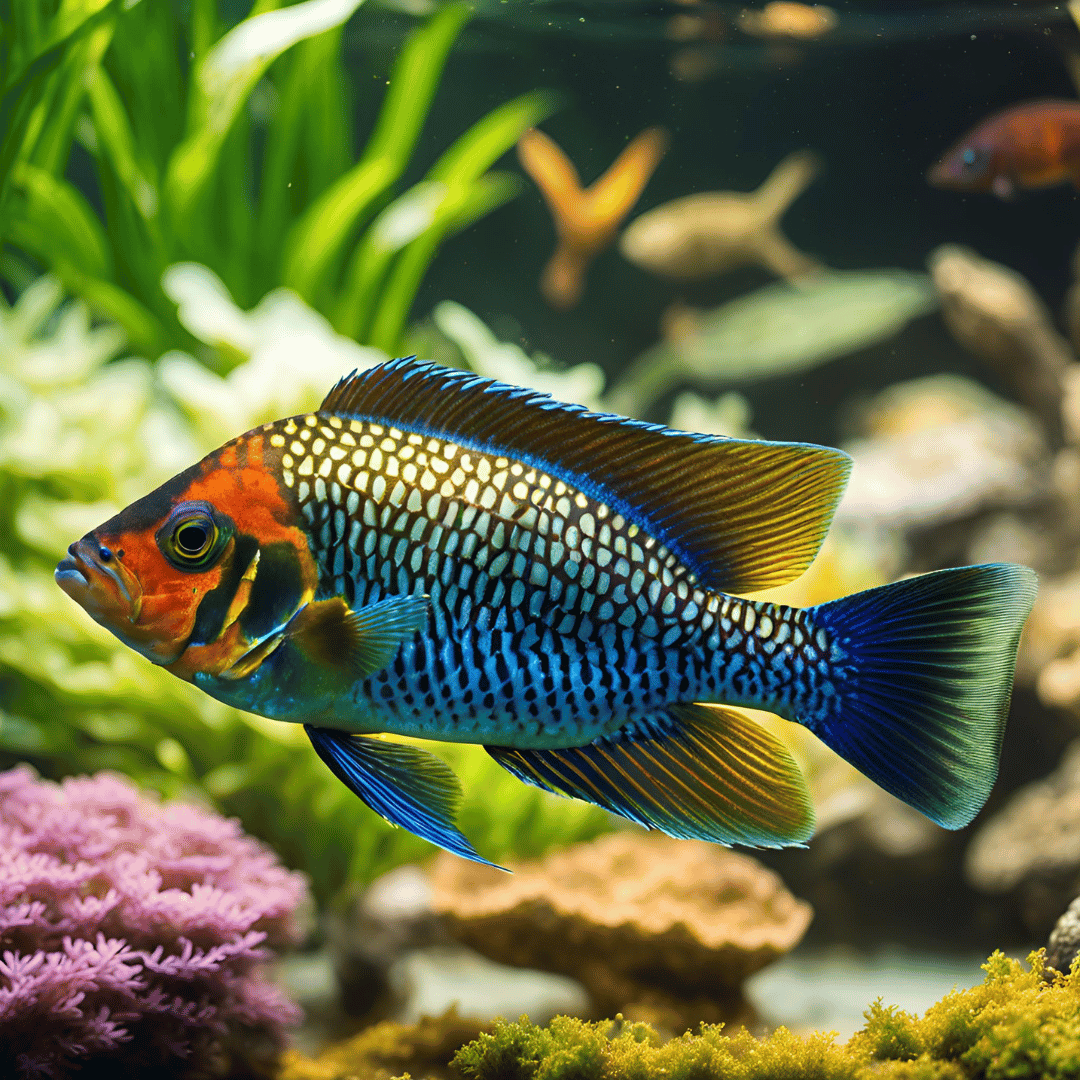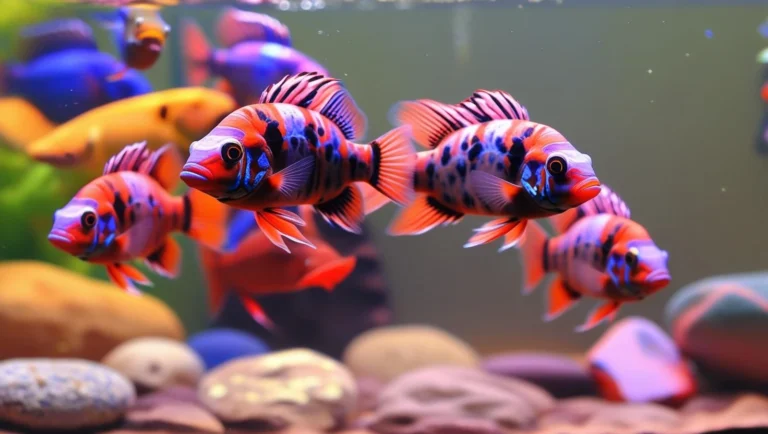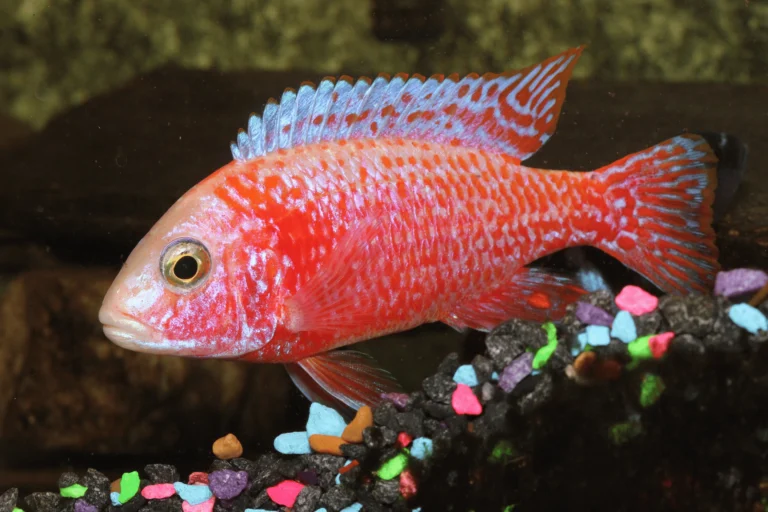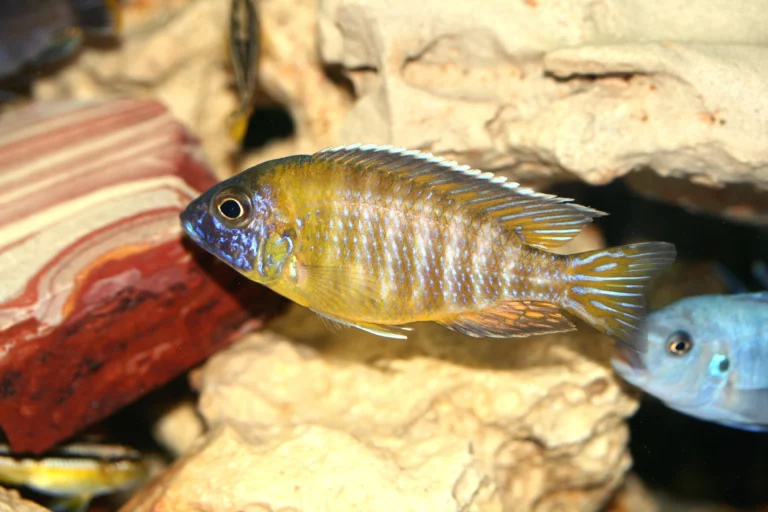Your trusted guide to cichlid care, tank setups, and quality products.

5 Easy Tips for Identifying Male vs Female Peacock Cichlids
Learn how to identify male vs. female peacock cichlids with our comprehensive guide. Explore physical traits, behaviours, and tips for successful breeding.
Image credits Canva
Peacock cichlids are among the most visually stunning freshwater fish species for aquariums. Known for their vibrant colors and engaging behaviors, these African cichlids are a favorite among aquarists. However, if you’re hoping to breed them or simply want to understand their social dynamics better, knowing how to distinguish male vs female peacock cichlids is crucial.
This comprehensive guide will provide detailed insights into identifying male vs female peacock cichlids. Whether you’re planning to breed them or simply observe their interactions more clearly, understanding these differences is essential. We will delve into physical traits, behavioral differences, challenges with juveniles, and the role of gender identification in maintaining a harmonious aquarium environment.
At PeacockCichlid.com, we believe in transparency and honesty with our readers. Some of the links in this article are affiliate links, which means we may earn a small commission if you make a purchase through them—at no additional cost to you. These commissions help support our site, allowing us to continue providing expert advice, in-depth guides, and valuable content for Peacock Cichlid enthusiasts like you.
We only recommend products that we trust and believe will be beneficial for your aquarium. Thank you for your support!
1. Physical Differences Between Male vs Female Peacock Cichlids
Coloration Differences in Male vs Female Peacock Cichlids
One of the most obvious ways to differentiate male vs female peacock cichlids is through coloration. Male peacock cichlids are celebrated for their vibrant, striking colors, ranging from blues and yellows to oranges and reds. These vivid colors are primarily used for attracting females and asserting dominance within the tank. If you spot a brightly colored peacock cichlid, it is almost certainly a male.
In contrast, female peacock cichlids exhibit duller hues, often in shades of brown or gray. This muted coloration allows female peacock cichlids to blend into their surroundings more effectively, offering protection when guarding eggs or fry.
Key Insight: If you aim for a colorful display tank, focus on adding more males. However, a balanced male-to-female ratio is vital if breeding is your primary goal.
Size Differences Between Male vs Female Peacock Cichlids
Size is another factor to consider when identifying male vs female peacock cichlids. Males tend to grow larger, often reaching up to 6 inches or more. Female peacock cichlids are usually smaller, with a maximum size of around 4-5 inches.
While size alone isn’t always definitive, it becomes a reliable indicator when paired with other distinguishing traits.
Fin Shape in Male vs. Female Peacock Cichlids
Male vs female peacock cichlids also differ significantly in fin shape. Males typically have longer, more pointed dorsal and anal fins that contribute to their regal appearance. In contrast, females possess shorter, rounder fins. As males age, their fins may become more elaborate, whereas females maintain more modest shapes.
2. Behavioral Differences Between Male vs Female Peacock Cichlids
Territorial Behavior in Male vs Female Peacock Cichlids
Male peacock cichlids are known for their territorial behavior. They often stake out specific areas of the tank and defend them aggressively, especially during breeding. If you observe a fish constantly protecting a section of the aquarium, it is likely a male.
Female peacock cichlids, on the other hand, are generally less territorial. However, they may exhibit aggression when guarding eggs or fry. Their protective instincts make them more defensive rather than dominant like males.
Breeding and Courtship in Male vs Female Peacock Cichlids
Breeding behaviors offer another way to distinguish male vs female peacock cichlids. During courtship, males display their brightest colors and perform elaborate rituals, such as fin flaring and body wriggling, to attract females. Males may also create nests in the substrate to entice potential mates.
Female peacock cichlids take a more passive role during courtship. They evaluate the male’s display before selecting a mate. After mating, females often exhibit mouthbrooding behavior, where they carry fertilized eggs in their mouths until they hatch.
3. Identifying Juvenile Male vs Female Peacock Cichlids
Why Juvenile Male vs Female Peacock Cichlids Are Difficult to Distinguish
Sexing juvenile male vs. female peacock cichlids can be challenging due to their similar appearance at a young age. Juveniles typically lack the vivid colors and distinct fin shapes of adult males, making it harder to differentiate them.
When Do Male vs Female Peacock Cichlids Develop Distinguishing Features?
Male peacock cichlids generally begin developing their vibrant colors and pronounced fin shapes between 4-6 months of age. During this period, young males may still resemble females. Waiting until the fish mature can help ensure accurate identification.
Tips for Identifying Juvenile Male vs Female Peacock Cichlids
To minimize mistakes, observe the growth rate, fin development, and subtle changes in coloration over time. Juvenile males often start showing faint hints of their future vibrancy as they mature.
4. Why Identifying Male vs Female Peacock Cichlids Is Important for Breeding
Importance of Gender Balance in Breeding Tanks
Understanding male vs. female peacock cichlids is essential for successful breeding. Peacock cichlids are harem breeders, meaning one male mates with multiple females. An ideal male-to-female ratio is one male to 3-4 females. This balance prevents excessive aggression and reduces stress on females.
Role of Male Peacock Cichlids in Breeding
Male peacock cichlids actively court females by displaying vibrant colors and performing mating rituals. Their territorial instincts become more pronounced in breeding setups, as they guard their areas and attract mates.
Role of Female Peacock Cichlids in Breeding
Female peacock cichlids play a crucial role in the breeding process. After mating, they mouthbrood the fertilized eggs, ensuring their safety until hatching. Choosing healthy, robust females is vital for breeding success.
5. Common Misconceptions About Male vs Female Peacock Cichlids
Misconception 1: Only Males Display Color
While it’s true that male peacock cichlids are more vibrant, some females may also exhibit slight coloration under optimal conditions. However, these colors are much less pronounced compared to males.
Misconception 2: Only Males Are Aggressive
Although males are typically more aggressive due to their territorial nature, females can also display aggression, especially when protecting eggs or fry. Behavioral observations alone may not always be sufficient to determine gender.
Conclusion
Identifying male vs female peacock cichlids is a critical skill for aquarists aiming to create a balanced and thriving aquarium. From vibrant coloration and fin shapes to unique behaviors, the differences between male vs. female peacock cichlids are both fascinating and practical for tank management.
By paying close attention to physical and behavioral traits, even juveniles can eventually be identified with confidence. For breeding purposes, understanding the male-to-female ratio and their respective roles ensures a harmonious and productive environment.
We hope this guide has provided you with valuable knowledge about male vs. female peacock cichlids. Share it with fellow aquarists and visit www.peacockcichlid.com for more expert tips on these captivating fish!
We hope you found these tips helpful for easily distinguishing male and female peacock cichlids. To further support your journey in creating a thriving aquarium, be sure to explore our related guides at peacochcichlid.com.
For more advanced breeding techniques, check out “Breeding Peacock Cichlids: 5 Proven Tips for Massive Success”—an essential read for any aquarist looking to enhance their breeding success. If you’re interested in optimizing your feeding routine along with your breeding efforts, our “10 Proven Tips to Master Peacock Cichlid Diet and Breeding” article is packed with expert advice. And for those just starting out, “Peacock Cichlid Care: 7 Powerful Tips for Beginners” provides a solid foundation for proper care.
We’re always updating our content with fresh insights, so visit us again and follow our social media channels for the latest updates and community news. Happy fish keeping!
FAQ’s
Why is it important to distinguish between male and female peacock cichlids?
Identifying the sex of your peacock cichlids is essential for managing aggression, maintaining a balanced tank, and achieving successful breeding. Males and females exhibit distinct behaviours and physical traits that affect tank dynamics.
What are the primary physical differences between male and female peacock cichlids?
Coloration: Males have vibrant, striking colors, while females are typically duller, with brown or gray hues.
Size: Males grow larger (up to 6 inches) compared to females (4-5 inches).
Fin Shape: Males have longer, more pointed dorsal and anal fins, while females’ fins are shorter and rounder.
How can I identify juvenile male vs female peacock cichlids?
Juveniles are more challenging to sex since both sexes often appear dull. Male juveniles develop their vivid colours and fin shapes around 4-6 months of age. Patience is key when identifying the gender of young fish.
Are male peacock cichlids always more aggressive than females?
Generally, males are more territorial and aggressive, especially during breeding. However, females may also display aggression when protecting eggs or fry. Behavioural overlap can occur, so observing physical traits is equally important.
What is the ideal male-to-female ratio for a peacock cichlid breeding tank?
A ratio of one male to 3-4 females is ideal. This setup reduces stress on females and prevents males from over competing for mates, ensuring a harmonious breeding environment.
Can peacock cichlid females show colour like males?
While males are significantly more colorful, some females may display a slight hint of color under optimal conditions. However, their coloration will never be as bold or vibrant as males.
How do male peacock cichlids behave during courtship?
Male peacock cichlids display bright colours, perform elaborate fin flaring, and sometimes create nests to attract females. These behaviours are key indicators of male courtship rituals.
Why is mouth brooding important for peacock cichlid females?
Female peacock cichlids protect fertilized eggs by carrying them in their mouths (mouth brooding) until they hatch. This behaviour ensures the safety of the offspring in the tank.
Can I rely solely on behaviour to identify male vs female peacock cichlids?
Behavioural observations can help but should be combined with physical traits for accurate identification. For instance, a territorial fish might be a protective female or an aggressive male.
Where can I learn more about male vs female peacock cichlids?
For detailed guidance and expert advice, visit www.peacockcichlid.com, a dedicated resource for all things related to peacock cichlids.



